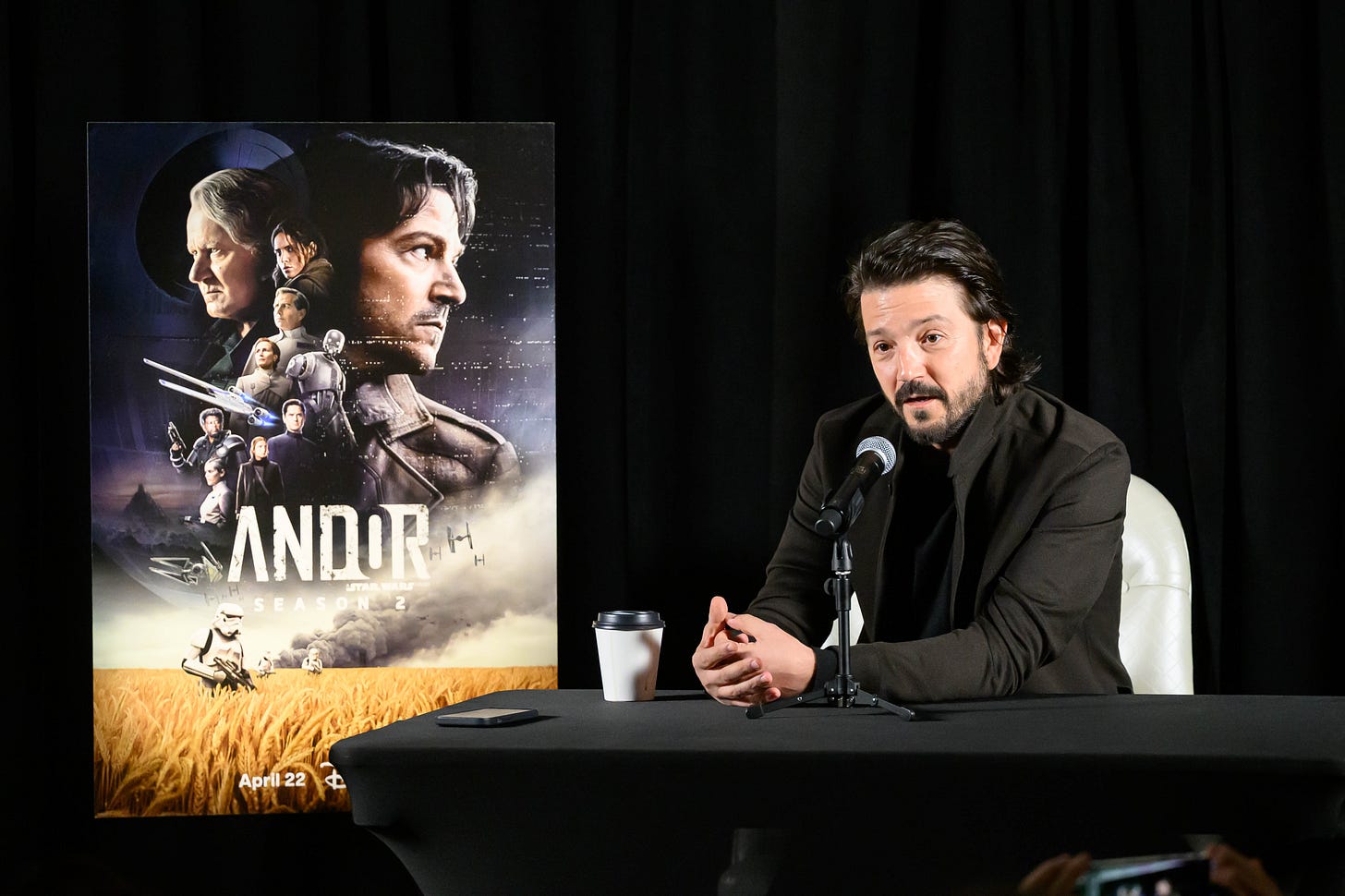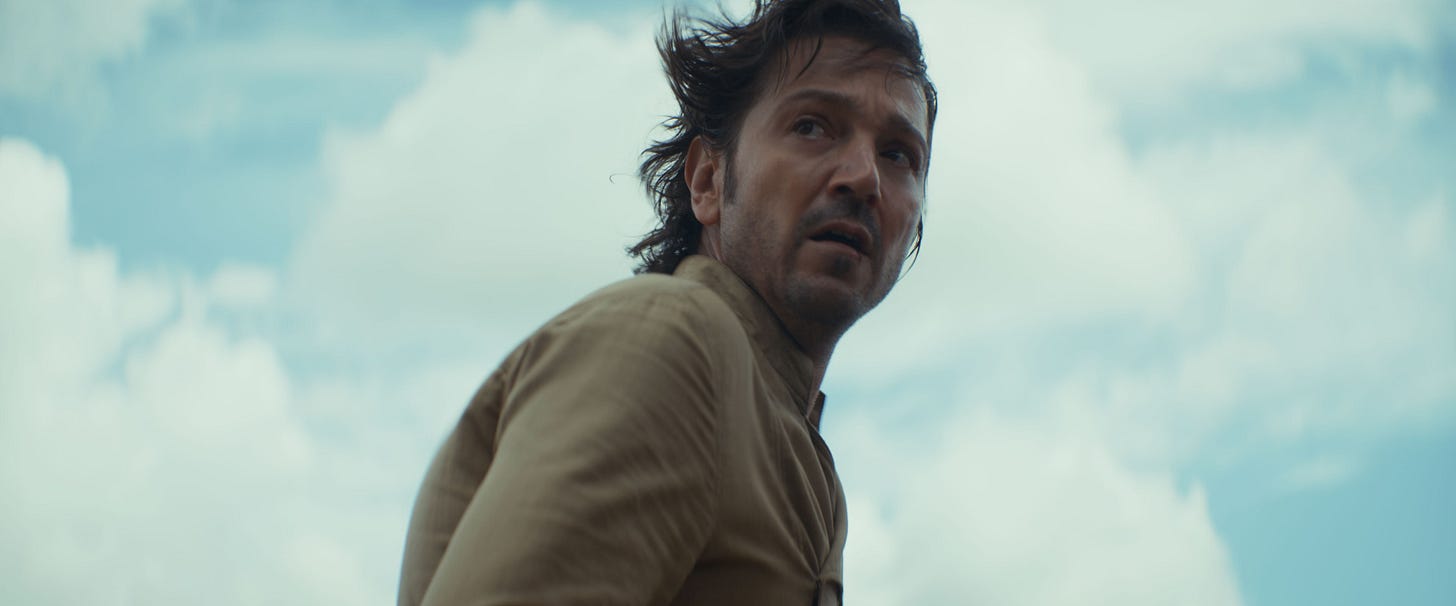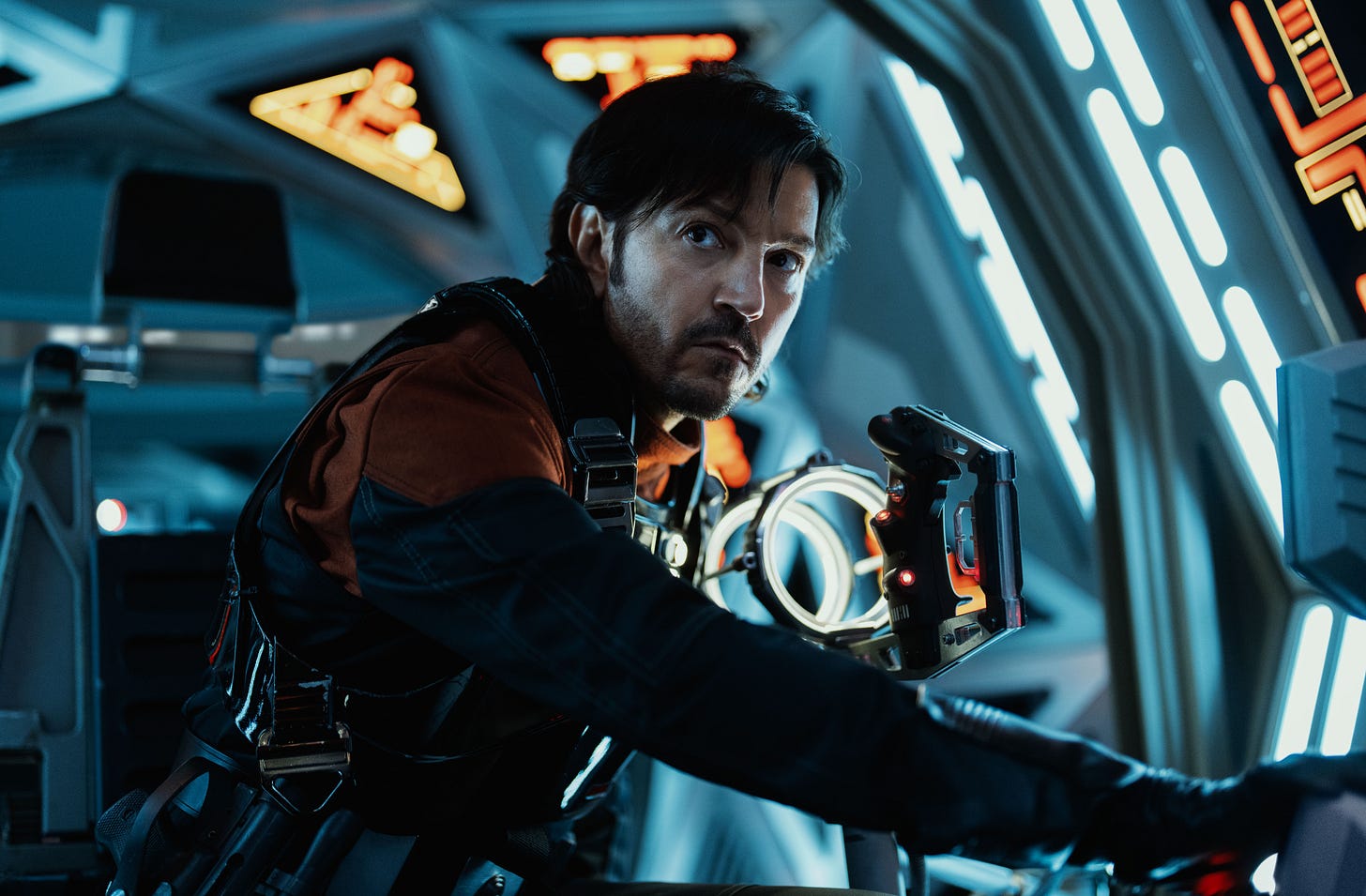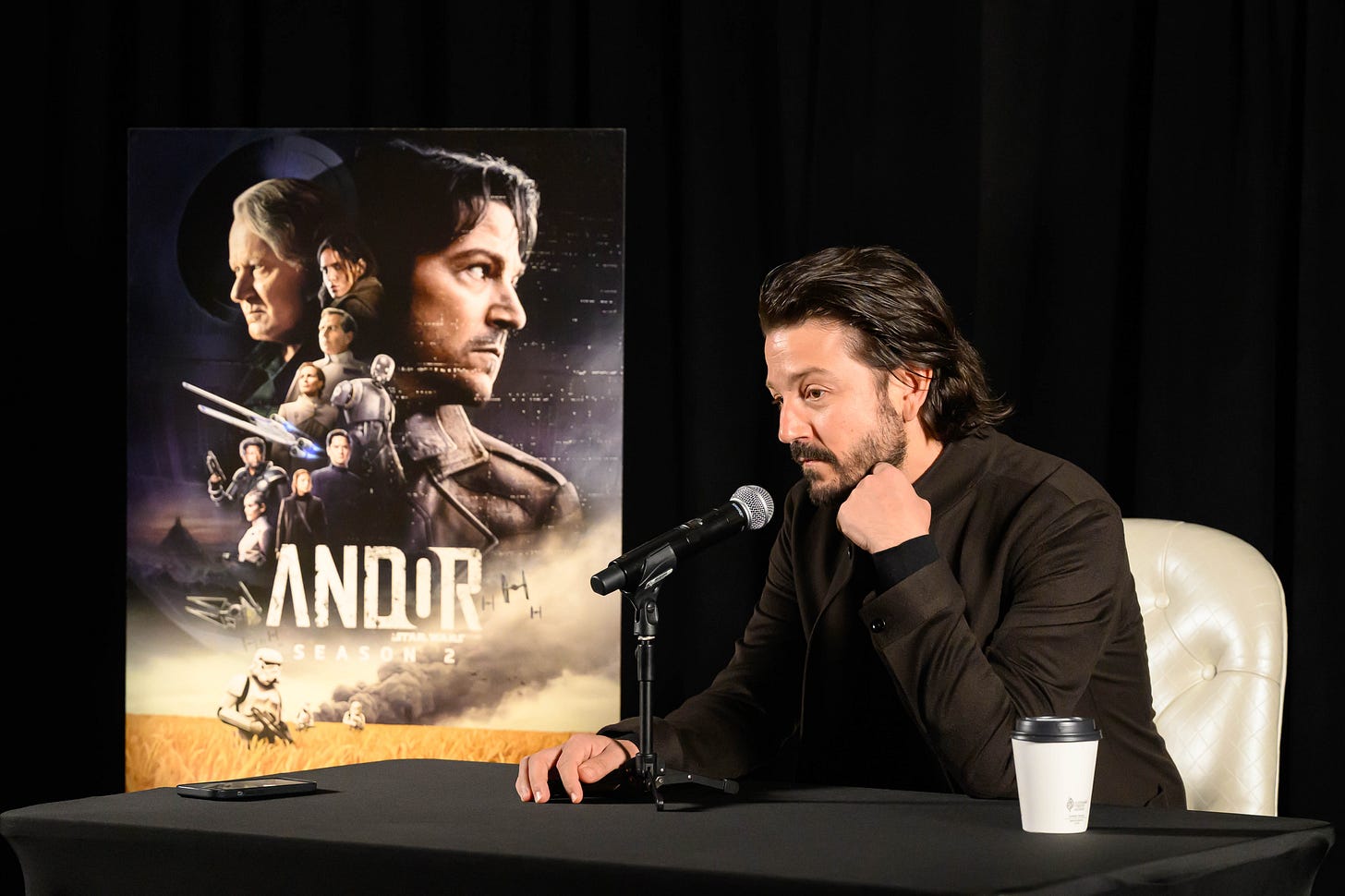'Andor' Q&A: Diego Luna
The actor and executive producer on saying goodbye to Cassian, building community, and making Star Wars personal
The second season of the hit Star Wars series Andor is here, and with it, the story of the dawn of the Rebellion can finally be told in full. First released on Disney+ in 2022, Andor received high praise from both fans and critics for its grounded, relevant storytelling and exceptional cast.
It’s the story of the rash and plucky scoundrel Cassian Andor, who unwillingly becomes embroiled in the early sparks of rebellion against the Galactic Empire. And with the second season—which leads directly into the events of the 2016 film Rogue One: A Star Wars Story—the full arc of Cassian, from displaced child to reluctant revolutionary, is now complete.
On April 15, 2025, Golden Globe voters were invited to a Q&A about the final season with actor and executive producer Diego Luna. Held at the Four Seasons in Los Angeles and streamed via Zoom, the session featured questions from Golden Globe voters both in the room and online.
Over the course of the conversation, Luna reflected on his decade-long journey with the character, the political resonance of the show, the importance of representation, and what it meant to build a story rooted in ordinary people and grounded places.
Here is the Q&A with Diego Luna:
Q: What was the first thing that drew you into Star Wars?
Diego Luna: I’ll tell you—the way I got into it, I was really young. I guess five or six years old. All my cousins were older than me. I’m the youngest. And they were all playing with lightsabers, all playing in this fantasy world I just wanted to belong to. I was a little late for those first films, but I’m sure the first one I saw was A New Hope, and I started from there—trying to belong. And then Darth Vader came into my nightmares. He stayed there for quite a long time.
I think I started loving cinema through these films. They were probably the first ones I really wanted to love—because they allowed me to connect with my cousins and be part of something that looked fun and interesting.
I think we’re very unfair to older cinema now. We’ve forgotten what it meant. Today there’s something new every night. Back then, you had to wait. One big opening a month, and you’d go to the cinema not knowing anything—who was in the film, what it was really about. Maybe you’d seen a poster and that was it. You had to trust your cinema and whoever programmed it.
There was mystery. And if one film didn’t work, sure, there was disappointment—but that relationship with cinema was beautiful. Now, if you don’t like something, you just skip it after two minutes. I didn’t grow up in that world. I grew up where every movie mattered. It was an event.
I had to wait three or four months to get a Darth Vader suitcase. You had to go to the toy store, put your name next to a number, and wait until they called you to say your toy was there. Now the toys are out before the movies.
Anyway, I was never disappointed by film. Sure, I liked some movies more than others. But I still love the secrecy of Star Wars—how it lets you be surprised, impressed, amused by something unexpected. We’re losing that. People sit down already knowing whether they’ll like something. That wasn’t possible for me growing up.
Q: You were deeply involved in Andor as both actor and executive producer. What made this project so important to you?
Diego Luna: First, let me just say very briefly to all of you here and those who are not here but are watching this—thank you. I don’t know if I said it enough, but what you did for La Maquina, that nomination meant a lot to all of us. It was beautiful to see our show, a project we made in Mexico, all in Spanish, being celebrated by you. We really appreciated seeing the name of our show on your list. We celebrated that as a team.
As for Andor, I’m passionate about this project because we got away with an idea we had six years ago—telling a very honest, very realistic story, as realistic as it can be in a galaxy far, far away. A story about people who want change. What needs to happen for a community to find the strength to organize, to spark a movement, a rebellion, a revolution? That was the idea. And I think we succeeded.
We succeeded because we had great material written by Tony Gilroy, a great leader in Tony. But also because we put together an incredible team—actors, designers, technicians—who believed in this project. We imagined something big, and it is big. And we reached the end without having to compromise, without giving up on what we set out to do. I’m very proud of that.
Q: You've spent more than a decade on Andor as both lead actor and executive producer. Now that it's over, how do you reflect on that experience?
Diego Luna: Thank you, yes. It’s been a long time. The first time I was invited to play Cassian was 11 years ago.
And so much has happened. But one thing I’m very, very happy with is that even today, as I say goodbye, I’m still in love—not just with the character, but with the story, with the people I’ve worked with, with the community that helped create this wonderful story. I’m in love with being here, talking about it. And this is the way to end things—when you’re completely passionate and still in love with it.
Otherwise, it makes no sense. I’m saying goodbye to a project that transformed my voice in many ways. I didn’t think it was possible to do something so personal and intimate with this level of resources and reach. This show gets my work in front of audiences I never imagined I’d reach. Tomorrow I’m flying to Tokyo to talk about it, then to New York. With Rogue One, we traveled around the world.
“I’m saying goodbye to a project that transformed my voice in many ways.”
And it’s nice to have that reach with something that still feels so personal. This project has that integrity. So yes, I guess the big lesson for me now is: if it doesn’t matter, don’t get involved. If it doesn’t matter to you, don’t do it—life is too short.
Q: What would you say to young Mexican fans who see you as an inspiration—especially those who never imagined seeing someone like themselves lead a Star Wars project?
Diego Luna: Well yes, we live in good times in that sense. Audiences today have a lot to say about what’s out there. And because of new technologies and the way things are distributed, audiences are sending the right message: we want to be represented. We want stories that reflect our context and who we are. And audiences today are celebrating specificity.
I grew up watching films where everything was in English and the villains always had strange accents. No one buys that anymore. Today, if you're telling a story set in Mexico, you want it to sound like Mexico. Same for North Africa, or anywhere else. So, the only thing I’d say to young people is: you have power as a consumer. I learned that while doing the César Chávez film in Los Angeles. He said, “Talk to the consumer—that’s how you shape the industry.” And it’s true.
Every time you buy a ticket, every time you click to watch something, you’re sending a message. You’re supporting the existence of something. And when you choose not to engage, that’s also a message. If you want stories in your language, about your world, with people who look and sound like you—click. The industry will listen.
One thing Lucasfilm has done well is respond to that. Just look at how Star Wars has changed since the ‘70s. It reflects our world today, and that’s because of what the audience asks for. We have the power to make sure the things we love keep getting made—and to push back on the things we don’t.
That’s also something we should all be doing.
Q: As both actor and producer, how was your experience working with Danish director Janus Metz—and the other international directors, Ariel Kleiman and Alonso Ruizpalacios?
Diego Luna: One good thing about the way Tony likes working is that he gives directors all the tools they need, but then he lets them be. When we shot this, it felt like a film in many ways. Each director had three episodes, and that’s one block of the story, which takes place over a year. Then there’s a time jump, and another block, and another, all the way to Rogue One. So each director had a story with a beginning and an end—something complete in itself.
With Janus, what’s great is that he has a very strong chapter in this second and final season. Very emotional. You’ll see. I don’t want to spoil anything, but it’s a very dramatic block he directed.
What’s beautiful about this is that directors come in and bring their own perspective. They have to follow certain rules that Tony gives all of us, of course. And we had amazing scripts. As actors, we knew what we were doing. But the directors still brought something unique to each block, and that makes each one its own thing.
Even though we were doing a long-form TV series, we ended up making eight films—because that’s what we know how to do. We’re old-fashioned; we grew up watching movies, and we ended up making movies. Over the last six years, we’ve been shooting eight films. And now we’re releasing four.
Q: As a director yourself, how does that side of your work influence you—and what can you tell us about your upcoming projects?
Diego Luna: I like directing more than anything, because everything I know as an actor helps me get the best out of the actors. It helps me understand storytelling from a perspective that I think is special. And by directing, I also learn a lot from others. Directing to me is like conducting.
You obviously have an idea. You establish what point of view will be behind that idea, but then you allow your idea to be challenged by everyone else’s perspective. And it’s beautiful. Because yes, you can learn a lot. If you surround your films with people who are talented and you can learn from, it’s always a blessing to get to the end.
As for the Jennifer Lopez film—it was a wonderful shoot. Getting to see her work was incredible. The commitment she brought—it’s like two films in one. What makes the project very special is that it’s based on the musical theater play Kiss of the Spider Woman. It screened at Sundance and went really well. I’ve read it’s coming out in October.
It’s a Bill Condon project, and he’s an amazing director, writer, a beautiful artist, and a theater lover. So I was pleased to work with him.
Next, I don’t know exactly, because I need to edit the film I just directed. It’s based on a book called Ceniza en la boca, written by Brenda Navarro. We shot in Barcelona, Madrid, and Mexico. I’ll start editing as soon as I finish the Andor tour. That’s the next thing for me.
Q: Looking back on your career, what do you think has helped you accomplish so much—and what’s been the biggest challenge of being both actor and producer on Andor?
Diego Luna: First of all, thank you. It’s a good reminder—25 years since Y Tu Mamá También. Long time. And many of you were there. I remember. I’m very, very pleased, because I am still very excited about what’s happening in my life.
I’m still discovering stuff. I come to these events very proud of what I’m here to talk about. And I still have that energy I had 25 years ago. I’m still in love with what I do, and I still believe in it. I still want to go through the whole process. I thought by now I’d be kind of bored with everything around movies, but I’m still very excited by what movies generate.
The interaction they bring to your life—going to festivals, finding audiences, talking to people, seeing the reaction to something you made with friends and family, something you crafted for years and then finally put out there—I love that interaction. I see myself doing this another 25 years for sure.
I started in theater, and I think the rigor and commitment this job requires was taught to me by theater people. Theater happens every weekend. And it needs the same energy every day. You have to show up. You have to be there. I was surrounded by people who taught me that you have to give everything if you want to do this job. It was a great place to grow up. I had fantastic references when I was a kid.
One thing that’s changed is that I’m a father now. If something has nothing to do with my kids—if I don’t want them to see it—then there’s no point in doing it. That’s the only rule that’s changed in my life. Before, I was making choices from a more egocentric perspective. Now I want to do stuff my kids can be proud of, that they can see and share with me.
I’ve been very lucky and privileged. I’ve always been asked to come—I’ve never had to wait in line for something to happen. But that’s theater too. Theater can happen right now. If I start telling you a story and there’s light, a little stage, and you’re listening—that’s theater. I’ve got your attention. I can do my job. Theater happens easily.
So, because I always had theater, I was never waiting for a film or a project to come. I was always surprised by the projects that did come. I was always asked to go somewhere, and that makes me feel very fortunate, because I know that’s not everyone’s reality.
But I think these are good times. I think TV and this long format have created a new space for actors. The chance to show what you’re capable of in projects like this is different from what film used to offer. Look at how many cool actors we’re meeting now because of long format. There are newcomers all the time. Actors get interesting roles very early in their careers these days. And I think that’s a good thing. I’m excited for that.
Q: One of the planets in Andor is covered in wheat fields, as seen on the poster. How important was it for you to ground the show in realistic environments rather than typical sci-fi landscapes—and where were those scenes filmed?
Diego Luna: I like your question, because it’s true—we focused on that a lot. How can we make this accessible? It has to feel realistic. We have to follow every rule of this galaxy far, far away, but this show is about the people. I don’t think we’ve ever really taken the time in Star Wars to see how people live in that galaxy.
How regular people live in this galaxy far, far away. I remember one thing we used to say with Rogue One: it’s a story about regular people doing extraordinary things. That film was well received, and audiences really liked it. So Lucasfilm said, “Let’s do a long-format show about these regular people.” But the approach had to be precise and different. We had to figure out what everyday life looks like in this place.
First, they built Ferrix for season one. It was like a little city, and everything made sense. You could get lost in it. The sets were real—things worked. You pushed a button and something happened. Doors opened and closed, there were windows, you warmed your food, there was a mechanic who fixed your vehicle. It was all real—as real as you can portray something in this galaxy.
This season is more ambitious. We go through four years, so we visit more planets, more realities, more communities. It’s nice to see how different life can be across these places. I’m very pleased with the whole team. The design of this show is so well crafted, with so much attention to detail, that acting becomes really fun and easy. You’re just reacting. You don’t have to imagine or pretend.
We weren’t working with blue screens or green screens or giant LED volumes. No—we were on location. We shot in many places across the UK. And we were patient. The story of the crops is interesting—they had to grow. You can’t just show up and shoot whenever you want. That’s how this show works. Like old movies, where the location tells you what you can and can’t do.
We weren’t working with blue screens or green screens or giant LED volumes.
We went to Valencia to shoot in an amazing building. And the building gives you tools—it sets rules. I love that in season one, something happened in Scotland. The characters are in the mountains, planning where they’ll go in the morning and deciding if it’ll be dangerous. When we arrived, a huge cloud covered everything. You couldn’t see more than a meter. So the scene had to change.
Tony was there, and we rewrote the lines to make the location work. That kind of accident brings out the best in creativity. That’s how this show was made. So it was really cool, really exciting every day—to go to work and find out what the location would tell us.
Q: Star Wars is set in a galaxy far, far away, but the stories often reflect real-world issues. What do you think audiences in 2025 can take away from Andor—and is it just a coincidence the show is about rebellion right now?
Diego Luna: Are you inviting me to something? Is there a secret meeting happening after this?
I’ll tell you one thing—Tony Gilroy is a very honest writer. He writes about what he cares about, what worries him. And from the beginning—this goes back six or seven years—we wanted to tell the story behind the huge sacrifice some rebels make in Rogue One. We wanted to explore what gets someone to that point. What makes you willing to sacrifice everything for a cause? That’s what we had in mind.
What’s behind a revolution? What’s the social climate, the political climate behind that ultimate sacrifice? His writing reflects the world he lives in. It reflects recent history—his history, mine, everyone’s. Everyone brings their own context to this.
The only thing we’re not good at is predicting. We never sat down and said, “Where will the world be in 2025?” We wanted the show to feel relevant to us while we were making it. The real question is: why don’t we learn? We tend to make the same mistakes over and over. History just repeats. Sadly, this show is relevant today, and probably will be in 20 or 50 years. It was relevant 20 years ago too.
The strength of community is always something worth being reminded of. What we’re capable of when we come together—when we focus on what connects us, when our differences become our strength instead of what divides us. That’s what this show is about. And that’s what Rogue One was about too.
The strength of community is always something worth being reminded of.
It feels so relevant because Tony Gilroy is such a good writer. We can blame him. Definitely.
Also, one thing actors really appreciate about this show is that it doesn’t judge the characters. It just exposes a reality. Everyone has a reason to be where they are. This is a story about revolution, but we see both sides. We take the time to enter each character’s world and understand what moves them.
This show lives in the gray areas. It’s not about good people and bad people. The world isn’t like that. Everyone has their reasons. The show doesn’t make judgments—it lets the audience explore and decide what part of the story they connect with. It doesn’t tell you, “These are the good ones, care about them.”
And now we understand what Cassian meant when he said, “We’ve all done terrible things for the Rebellion.” That line from Rogue One—now you have images. Now you go, “Oh shit, he meant that. Damn. That’s dark.” But yes, of course. The honesty of the show is what makes it so relevant. It’s honest, bold, and open.
Check out the Q&A with Tony Gilroy here:
'Andor' Q&A: Tony Gilroy
The second season of Andor brings the story of rebellion to its turning point, and behind it all is creator and showrunner Tony Gilroy, returning to finish what he started with Rogue One.







